
[Image: What would happen, I suppose, if Toll Brothers went into genetic engineering: it’s Geoff Shearcroft‘s “Grow Your Own” – probably not what New Scientist had in mind… but could you grow a whole city from the spines of cloned mice? Would anyone ever live there? What would a house fire smell like…?].
Category: BLDGBLOG
The hedge-bridge
There was a show in London last summer, organized by RIBA, called Fantasy Architecture: 1500-2036. (You can read a review of it here, with images).
The show included this amazing bridge design, which has been tacked to a bulletin board behind my desk for nearly a year; I finally scanned it.

[Image: A bridge over the River Avon, by “W. Bridges”].
An excellent companion book was produced for the exhibition, making a worthy and stimulating start to the new year –

– yet that initial bridge also reminds me of a post on Pruned, about the unbuildable, speculative architectural designs of Alexander Brodsky and Ilya Utkin, which included this insane kind of bio-architectural hedge-bridge. Houses growing atop houses.

Combining this and the bridge above, however, I’m left wondering if you could grow a bridge out of coral? A whole continent-wide system of Roman aqueducts? Somehow train the coral, or guide its barnacled growth, upward into an arc – then walk over it. Sail ships under it.
Or would that form the first legally-recognized case of landscape abuse? Mistreating your living bridges?
(See Pruned or the nonist for more; then order this book).
Bridge, Ruin, Arches

[Image: The Brooklyn Bridge cutting over an arched labyrinth of brickwork; Keith Kin Yan/Overshadowed].
Urban Diptychs
[Images: Traffic diptychs by Keith Kin Yan, from his bewilderingly addictive site overshadowed. There are about 5000 other photographs I’d like to re-post here… so bear with me if a few more show up soon. Found via the intimidatingly excellent things magazine].
Optometric Metropolis
 [Image: Urban optometry, the watchful walls, a CCTV utopia (via Bryan Finoki and Enjoy Surveillance)].
[Image: Urban optometry, the watchful walls, a CCTV utopia (via Bryan Finoki and Enjoy Surveillance)].
Silt
The surface of the planet renews itself through geothermal hydrology, sulfuric lakes, new continents of silt –

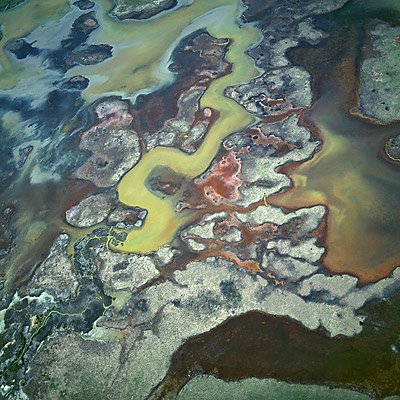
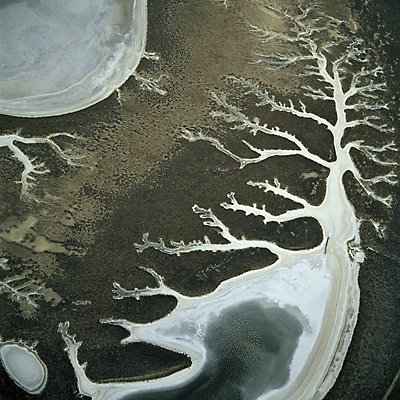
– as natural acids scour shapes in slow terrains.
These are all photographs by Bernhard Edmaier, whose work can be found on his own website –
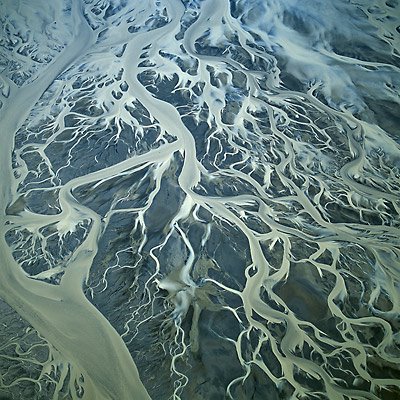
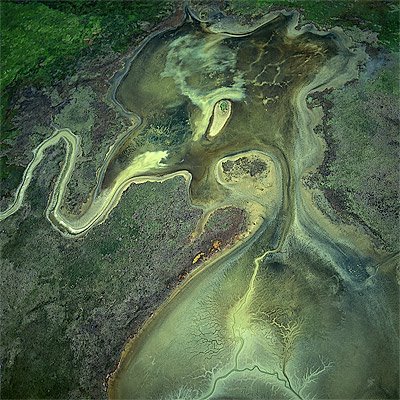
– and in the beautiful (if unfortunately named) Earthsong.
Meanwhile – though I repeat myself – these bring to mind J.G. Ballard’s novel The Drowned World, with its vision of a flooded, neo-tropical Europe, London become a backed-up toilet full of silt and Jurassic vegetation, “a nightmare world of competing organic forms returning rapidly to their Paleozoic past.”
Huge iguanas laze around in the heat. Buildings left and right are collapsing, their lower six floors immersed in polluted seawater, “miasmic vegetation… crowding from rooftop to rooftop.”
The city is fossilizing.
As Ballard writes: “A few fortified cities defied the rising water-levels and the encroaching jungles, building elaborate sea-walls around their perimeters, but one by one these were breached. Only within the former Arctic and Antarctic Circles was life tolerable.”
So the story goes that a research biologist is touring this neo-tropical London, boating from hotel to hotel across fetid lagoons, recording the types of plants that infest the city. Meanwhile monsoons are coming up from the south, everyone is dying of skin cancer and no one can sleep. The intensity of the sun’s radiation is making everything mutate.
In between some eyebrow-raising moments of ridiculous, pop-Nietzschean pseudo-philosophy – the surviving humans find themselves psychologically regressing down the totem pole of evolution toward… something or other; it’s all very psychedelic and 2001 – there are some cool descriptions of these new urban tropics:
“Giant groves of gymnosperms stretched in dense clumps along the rooftops of the submerged buildings, smothering the white rectangular outlines… Narrow creeks, the canopies overhead turning them into green-lit tunnels, wound away from the larger lagoons, eventually joining the six hundred-yard-wide channels which broadened outwards toward the former suburbs of the city. Everywhere the silt encroached, shoring itself in huge banks against a railway viaduct or crescent of offices, oozing through a submerged arcade… Many of the smaller lakes were now filled in by the silt, yellow discs of fungus-covered sludge from which a profuse tangle of competing plant forms emerged, walled gardens in an insane Eden.”
In any case, one could easily imagine Bernhard Edmaier’s photographs here bearing much in common with Ballard’s new alluvial world of fresh earth, architecture reduced to deltas of sand. Old eroded reefs of brickwork. Lagoons of pollution.

Erosion and hydrology, the most powerful urban forces on earth.
R.I.P.: 2005 AD
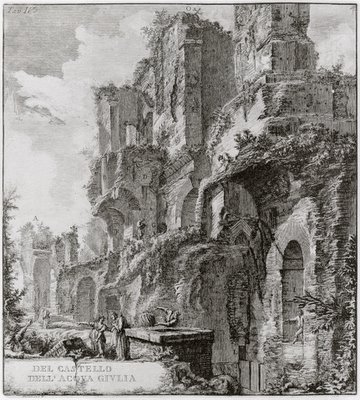
[Image: G.B. Piranesi, from the endlessly stimulating Complete Etchings].
Happy 2006…
Drainscaping Nevada’s Gold

A series of articles on gold mining continues again at the New York Times, this time focusing on the state of Nevada’s groundwater.
“Nearly 10 million gallons a day draining away in the driest state in the nation… is just one of the many strange byproducts of Nevada’s tangled love affair with gold.”


[Images: Barrick‘s Goldstrike Mine, Nevada; all photos by Ashley Gilbertson/New York Times].
“Large-scale open-pit mining takes a lot of water, millions of gallons, mostly to dilute the cyanide that miners use to soak their ore and separate its microscopic bits of gold.” This, in tandem with mass pumping and the use of settling ponds, “could change both the quantity and quality of the groundwater, and even the shape of the aquifer.”

Nevada, however, seems to have escaped the attention of the environmental movement: “‘Nevada is mostly not prized by environmentalists,’ said John D. Leshy, who was the top lawyer for the Department of the Interior in the Clinton administration. ‘Nevada is being written off as a sacrifice area for gold.'”
(For more information see the actual article; and for a bit on gold in Indonesia, see BLDGBLOG’s earlier post).
Famous Hulls of the Alaskan Sea

[Image: Philipp Scholz Rittermann].
I scanned this interior view of a ship’s hull from a postcard I received yesterday. The voluminous, cathedral-like reinforced buttressing of the ship’s inner hull is all the more remarkable when you realize that this is the Exxon Valdez Under Construction.
Do future catastrophes offer hints in the details of the past?
(Thanks, Dan).
Student projects 4: The scrap lung
BLDGBLOG’s year-end look at cool student projects continues now with the Scrap Lung by Russell Pearce, winner of a Serjeant Award at this year’s Royal Institute of British Architects’ President’s Medals ceremony.


The project comes with these awesome little machine-diagrams –

– that show “hydro-arms… constructed from degrading machinery.”

It then proceeds through a series of exquisite mechanical studies illustrating “the motion of canal pumps and grapple cranes across the envelope of the architecture” –



– before framing the spatial realization of the ultimate form (a “degrading membrane, leached with iron oxide”), in the process demonstrating how the building will be used and inhabited.


Pearce’s design statement includes the following rather cryptic description: “Conversations formed amongst degrading machinery and hydrolysis limbs, etching time based vectors into their tissue and leaching iron oxide poetically across the architectural membrane. Capillaries of canal fluid percolate through its skin, chemically distilled, generating energy to clean, paint, heat, and breathe new temporary fabrics towards the city.”
It’s architecture come to life, breathing itself through a scrap lung.
Someone sign this man a film contract.
(Spotted via Archinect).
The knot driver
Northern Baltimore’s I-95/695 highway interchange is a “topological masterpiece,” and its superb “mathematical aesthetics” might just save it from being destroyed.
 [Image: “I was in a web of braided highways.” New Scientist].
[Image: “I was in a web of braided highways.” New Scientist].
“In the spring issue of The Mathematical Intelligencer, Michael Kleber, a topologist at MIT, waxed enthusiastic about [the interchange’s] ‘non-trivial braiding‘: while it is possible to just lift I-95 up and away from I-695, the northbound lane of I-95 braids both over, and then under, the southbound lane, making it impossible to pull them apart without cutting one of the lanes.”
 However, those simultaneous right/left exits don’t seem to be helping with traffic flow, and the system’s moving circular symmetry may soon be traded-in for something far simpler.
However, those simultaneous right/left exits don’t seem to be helping with traffic flow, and the system’s moving circular symmetry may soon be traded-in for something far simpler.
“I don’t want to encourage more cars onto the roads,” the New Scientist writes, “but if topology and beauty mean anything to you, get out there and enjoy I-95/695 now. It may soon be too late.”
 This leads me to wonder, of course, if you could take-over the U.S. Department of Transportation, and rebuild the nation’s highway infrastructure as a massive textbook in driveable knot theory.
This leads me to wonder, of course, if you could take-over the U.S. Department of Transportation, and rebuild the nation’s highway infrastructure as a massive textbook in driveable knot theory.
Seattle to Chicago, you drive achiral knots; Los Angeles to Phoenix, trefoils; New York to Miami, Brunnian links; while the most complicated ones are saved for a private highway system built between Washington DC and Denver.
All the tunnels of Manhattan, recurved and cross-torqued through themselves, with some so maddening only postgraduate researchers can find their way out of the city.
A new Olympic sport: driving the New York knots.
(Earlier: BLDGBLOG’s Wormholes).




